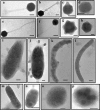Differential impact of lytic viruses on prokaryotic morphopopulations in a tropical estuarine system (Cochin estuary, India)
- PMID: 29534102
- PMCID: PMC5849291
- DOI: 10.1371/journal.pone.0194020
Differential impact of lytic viruses on prokaryotic morphopopulations in a tropical estuarine system (Cochin estuary, India)
Abstract
Our understanding on the importance of viral lysis in the functioning of tropical estuarine ecosystem is limited. This study examines viral infection of prokaryotes and subsequent lysis of cells belonging to different morphotypes across a salinity gradient in monsoon driven estuarine ecosystem (Cochin estuary, India). High standing stock of viruses and prokaryotes accompanied by lytic infection rates in the euryhaline/mesohaline region of the estuary suggests salinity to have an influential role in driving interactions between prokaryotes and viruses. High prokaryotic mortality rates, up to 42% of prokaryote population in the pre-monsoon season is further substantiated by a high virus to prokaryote ratio (VPR), suggesting that maintenance of a high number of viruses is dependent on the most active fraction of bacterioplankton. Although myoviruses were the dominant viral morphotype (mean = 43%) throughout the study period, there was significant variation among prokaryotic morphotypes susceptible to viral infection. Among them, the viral infected short rod prokaryote morphotype with lower burst estimates (mean = 18 viruses prokaryote-1) was dominant (35%) in the dry seasons whereas a substantial increase in cocci forms (30%) infected by viruses with high burst size (mean = 31 viruses prokaryote-1) was evident during the monsoon season. Such preferential infections of prokaryotic morphopopulations with respect to seasons can have a strong and variable impact on the carbon and energy flow in this tropical ecosystem.
Conflict of interest statement
Figures





Similar articles
-
Viral-Induced Mortality of Prokaryotes in a Tropical Monsoonal Estuary.Front Microbiol. 2017 May 23;8:895. doi: 10.3389/fmicb.2017.00895. eCollection 2017. Front Microbiol. 2017. PMID: 28588564 Free PMC article.
-
Deciphering the virus-to-prokaryote ratio (VPR): insights into virus-host relationships in a variety of ecosystems.Biol Rev Camb Philos Soc. 2017 May;92(2):1081-1100. doi: 10.1111/brv.12271. Epub 2016 Apr 26. Biol Rev Camb Philos Soc. 2017. PMID: 27113012 Review.
-
Regulation of Low and High Nucleic Acid Fluorescent Heterotrophic Prokaryote Subpopulations and Links to Viral-Induced Mortality Within Natural Prokaryote-Virus Communities.Microb Ecol. 2020 Jan;79(1):213-230. doi: 10.1007/s00248-019-01393-9. Epub 2019 Jun 3. Microb Ecol. 2020. PMID: 31161232
-
Influence of hydrological factors on bacterial community structure in a tropical monsoonal estuary in India.Environ Sci Pollut Res Int. 2021 Sep;28(36):50579-50592. doi: 10.1007/s11356-021-14263-0. Epub 2021 May 8. Environ Sci Pollut Res Int. 2021. PMID: 33963997
-
Ecology of prokaryotic viruses.FEMS Microbiol Rev. 2004 May;28(2):127-81. doi: 10.1016/j.femsre.2003.08.001. FEMS Microbiol Rev. 2004. PMID: 15109783 Review.
Cited by
-
Assessment of Explicit Representation of Dynamic Viral Processes in Regional Marine Ecological Models.Viruses. 2022 Jun 30;14(7):1448. doi: 10.3390/v14071448. Viruses. 2022. PMID: 35891428 Free PMC article.
-
Genetic and functional diversity of double-stranded DNA viruses in a tropical monsoonal estuary, India.Sci Rep. 2018 Oct 30;8(1):16036. doi: 10.1038/s41598-018-34332-8. Sci Rep. 2018. PMID: 30375431 Free PMC article.
-
Top-Down Controls of Bacterial Metabolism: A Case Study from a Temperate Freshwater Lake Ecosystem.Microorganisms. 2022 Mar 25;10(4):715. doi: 10.3390/microorganisms10040715. Microorganisms. 2022. PMID: 35456766 Free PMC article.
-
Imaging Techniques for Detecting Prokaryotic Viruses in Environmental Samples.Viruses. 2021 Oct 21;13(11):2126. doi: 10.3390/v13112126. Viruses. 2021. PMID: 34834933 Free PMC article. Review.
-
Weekly variations of viruses and heterotrophic nanoflagellates and their potential impact on bacterioplankton in shallow waters of the central Red Sea.FEMS Microbiol Ecol. 2020 Apr 1;96(4):fiaa033. doi: 10.1093/femsec/fiaa033. FEMS Microbiol Ecol. 2020. PMID: 32149360 Free PMC article.
References
-
- Weinbauer MG. Ecology of prokaryotic viruses. FEMS microbiology reviews. 2004; 28(2):127–81. doi: 10.1016/j.femsre.2003.08.001 - DOI - PubMed
-
- Suttle CA. Marine viruses—major players in the global ecosystem. Nature reviews. Microbiology. 2007. 5(10):801 doi: 10.1038/nrmicro1750 - DOI - PubMed
-
- Breitbart M. Marine viruses: Truth or dare. Annual.Reviews in Marine Sciences, 2012; 4, 425–448. - PubMed
-
- Suttle CA. The significance of viruses to mortality in aquatic microbial communities. Microbial Ecology. 1994; 28(2):237–43. doi: 10.1007/BF00166813 - DOI - PubMed
Publication types
MeSH terms
LinkOut - more resources
Full Text Sources
Other Literature Sources
Medical

